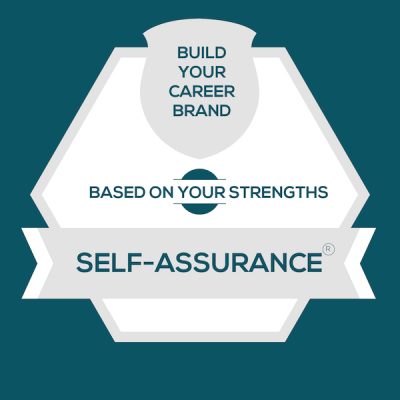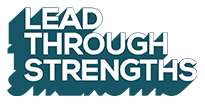Self Assurance Strength: Build A Genuine Career Brand
Podcast: Play in new window
Subscribe: Spotify | iHeartRadio | Email | TuneIn | More
 Self-Assurance Strength: Get Known For Your Talent
Self-Assurance Strength: Get Known For Your Talent
I get a lot of questions about how to align your CliftonStrengths talent theme of Self-Assurance with your career. In this series, I break down one strength per episode so that you can add to the insights from your StrengthsFinder report and make a better match between your job and your strengths.
- If you’re exploring as a manager, use this series for career development ideas and even new clues about responsibilities you could give a person with this talent theme so that they can show up at their best.
- If you’re exploring for yourself, use this as a chance to build a reputation for your strengths so that you’re more likely to be given assignments that live in your strengths zone.
The talent theme today is Self-Assurance. You’ll get three layers to chew on:
- Career Branding
- Red Flag Situations At Work
- Fresh Application Ideas
Career Branding For The Self-Assurance Strength
You probably already have a reputation for what you know. If you imagine your resume or your LinkedIn profile, I bet it's full of “the what,” which are things like job titles, skills, knowledge, expertise, or the degree you earned. What’s missing in most profiles is "the how,” and this is where your StrengthsFinder talent themes live. This is an overlooked use for tools like LinkedIn, which is not just for job seekers.
I bet you are just like my StrengthsFinder training clients, where you don’t see your teammates and customers every day. That’s why LinkedIn has become so important for career branding - because it’s the tool your teammates, customers, and vendors use to go look you up before a meeting - to see who they’re about to talk to. And rather than only telling them what you know, you should also give them a peek at how it is to work with you.
Here are a bunch of adjectives to consider using in your career branding efforts and your LinkedIn profile when you lead through the Self-Assurance strength:
- Independent
- Instinctive
- Self-Sufficient
- Stable
- Confident
- Solid
- Influential
- Certain
- Resilient
- Persistent
- Courageous
- Guide
Red Flag Situations When You Lead With The Self-Assurance Strength
These are the company cultures, interactions, or situations that feel like soul-sucking drudgery to someone with the talent theme of Self-Assurance. They might even make you want to quit the team. So I’ll give you a couple of these to be on the watch for — because if they fester, you might get the urge to quit the job or become detached at work.
Here are a couple of Red flags for the Self-Assurance strength (talent theme):
- False Collaborations. If you lead through the self-assurance strength and you’re partnered up with another person or another department when your opinion doesn’t really matter, it will drive you crazy. You will already know a direction you’d propose, and if your ideas constantly fall on deaf ears, you’ll feel totally soul-sucked by it.
- Hand Holding. If you work with someone who needs constant hand-holding, it will wear you out. You work independently and you expect others to at least try to figure it out on their own before leaning on you. And if you feel like someone is trying to constantly hand-hold you, you’re likely to resist and feel as if they’re treating you like a child or a newbie or a dummy.
3 Fresh Application Ideas For The Self-Assurance Strength
These are ways to apply the talent theme of Self-Assurance at work , even when the job duties on the team feel pretty locked in. If you’re listening as a team manager, be sure to have a conversation around these ideas. You’ll both be able to come up with places to apply them.
For someone who leads through the Self-Assurance strength, put this talent to good use with one of these options:
- When a critical issue comes up, think of the person who leads through Self-Assurance. This doesn’t mean to dump all of the problems on them. It means to look for situations where a lot is riding on the decision or execution (good or bad). Rather than being scared and hesitant as many would be, someone with Self-Assurance can confidently handle the challenge without getting ruffled.
- Watch for change that makes others nervous. Think about things like process changes, re-orgs, or mergers that make others fear that they’ll be redundant and lose their jobs. This is the situation where you can put the person with Self-Assurance out front to show people how to confidently and resiliently flow through major organizational changes.
- Assign this person to responsibilities that benefit from no second-guessing. Those with strong Self-Assurance have strong instincts and can move forward quickly. If you need someone who will not hem and haw over a decision, make this person your go to.
So there you have it. It’s a quick tour for building your career through the talent theme of Self-Assurance.
Here's Your Personal Branding Homework For The Self-Assurance Strength
- Go take action on your LinkedIn profile with the career branding section. Challenge yourself to write one sentence in the Summary section of LinkedIn that captures how you collaborate as a teammate at work.
- Then think over the red flags to see if there’s anything you need to get in front of before it brings you down.
- Volunteer your talents through the application ideas. And if you’re a manager, have a conversation with your team members about which of these things sound like something they’d love to have more of.
- Dig into the Self-Assurance strength all the way. You can really nerd out on the nuances on the Self-Assurance Talent Theme Page.
Here's A Full Transcript Of The 8 Minute Episode
You're listening to Lead Through Strengths, where we help work teams apply their greatest strengths at work. I'm your host, Lisa Cummings and I got to tell you, it's hard to find something more energizing than using your natural talents every day at work. And as you might expect, I get a bunch of questions about how to align your CliftonStrengths talent themes, with your career plan, or with your career branding.
So in the series, I break down one strength per episode. This time, it's Self-Assurance, so that you can add to the insights from the StrengthsFinder report and make a better match between your job and your strengths. If you're listening as a manager, use this series for career development ideas or clues about the responsibilities, tasks and assignments you could give a person with this talent theme, so they can show up at their best every day. And if you're listening for yourself, because you lead through Self-Assurance, use this as a chance to think about how you can build a reputation for yourself self-assurance so that you're more likely to be given assignments that live in your strength zone.
So, you get 3 layers to chew on. One is career branding. The second is red flag situations you need to watch out for at work. And the third is fresh application ideas.
So, let's start with career branding. Now you probably already have a reputation for what you know. These are things like titles, skills, knowledge, expertise, or degrees that you've earned. Things like that. What's missing in most of your profiles on LinkedIn, or even your resumes is the how, and this is where your StrengthsFinder talent themes live. These are your superpowers.
This is an overlooked use for the tool of LinkedIn. And that tool is not just for job seekers because I bet you're just like my StrengthsFinder training clients, where you don't actually see your teammates or your customers every day. That's why LinkedIn has become so important for career branding, because it's how your teammates and your customers and your vendors go look you up before a meeting because they want to know who they're about to talk to. And rather than only telling them what it is, you know, or what job titles you've had in the past, you should also give them a peek at how it is to work with you.
So here are a bunch of adjectives that you could consider using in your career branding effort, right in your LinkedIn profile in the summary section. So, people who lead through Self-Assurance are often independent. They're instinctive. They're self-sufficient. They're stable. They're resilient. They're competent. They're courageous. They're solid and influential, certain and persistent. Powerful stuff.
Now, let's move to the red flag situations at work. These are the type of cultures, the type of interactions or even the situations that are going to feel like soul-sucking drudgery to you. If you have Self-Assurance, they might even make you want to quit the team. So, I'll give you a couple of these to be on watch for because if you let them fester, you might get the urge to quit your job, or become detached at work, or be the one who is actively disengaged on the team.
So here are two important red flags for Self-Assurance. One is false collaborations. If you lead through Self-Assurance, and you're partnered up with another person or another department, when your opinion really doesn't matter, it's going to drive you crazy. If you already know a direction that you'd propose, which you likely do if you have Self-Assurance, but then your ideas are constantly falling on deaf ears, you're going to be totally soul-sucked by it.
So, watch out if you feel that false collaborations are a big part of your job. The second one that's important is watch out for hand-holding. And this goes in both directions. If you work with somebody who needs constant hand-holding, it’s going to wear you out because you work independently, and you expect that others are going to at least try to figure it out on their own before they lean on you. And in reverse, if you feel like someone is constantly trying to hand-hold you, you're likely going to resist and feel as if they're treating you like a child or like a newbie or like a dummy. So those are all big draining factors for Self-Assurance.
All right, now let's pivot to three fresh application ideas for Self-Assurance. So, these are ways to apply the talent theme at work. If this is your talent theme, this is how you can volunteer them. If you're listening as a team manager, these are things that you could do to assign work in the area of Self-Assurance so they can be at their best at work.
So, for someone who leads through Self-Assurance, put that talent to good use with one of these options. Here are 3.
One, critical issues. So, when a critical issue comes up, think of the person who leads with Self-Assurance. This doesn't mean dump all problems on them, but it means look for situations where there's a lot riding on a decision or a lot riding on the execution that is done well. This could be good or bad stuff that's riding on it, because rather than being scared or feeling hesitant as many people would be, if they had something that is so high pressure, and so high stakes, someone with Self-Assurance, they're going to competently handle the challenge. They're not going to get ruffled. So really nice type of assignment to get them.
Second, watch for change that makes others nervous. Think about things like process changes, or reorgs, or mergers, big stuff - things that make other people fear that they're going to be redundant, they're going to lose their jobs. And this is a situation where you can put a person with Self-Assurance out front, to show people how to confidently and resiliently flow through big organizational changes, how to apply their talents to new situations, and put that on praise.
Third idea is to assign this person to responsibilities that benefit from not second-guessing, because if you're strong with Self-Assurance, you're going to have really strong instincts, and they're going to be people who can move forward really quickly. So, if you are a manager who needs someone who isn't going to hem and haw over a decision, make this person your go-to. If you need it done, you need it done now, you need it done competently, not backing water. Boom, pick someone with Self-Assurance.
So, there you have it. That was a quick tour for building career through the talent theme of Self-Assurance. So, here's the homework.
One, take action on LinkedIn profile. If this is your talent theme, go think about career branding, and challenge yourself to write one sentence that integrates some of those adjectives, at least one of them in the summary section of LinkedIn, to capture how you collaborate as a teammate.
The second one, think over those red flags. If this is your talent theme, see if there's something you need to get in front of before it brings you down. You might need to reframe it, get in a new state before it becomes an issue. If this is a person that you manage, and you're a manager with someone who has Self-Assurance on the team, and these red flags represent your culture very strongly, watch out because this is something that will be a real drain and soul sucking factor.
And then third, finally, if this is your talent theme, volunteer your talent themes in those 3 application ideas. If you're a manager, have a conversation with your team member about how you could actually apply those to your situation.
So, with that, I'm your host, Lisa Cummings from Lead Through Strengths. If you're thinking about doing a virtual or in-person StrengthsFinder event to kick-off your strengths-based culture, head on over to leadthroughstrengths.com/training to see if our current offerings are a good fit for you.
So, until next time, thank you for being part of this powerful strengths movement that helps people unleash the awesomeness they already have inside.

